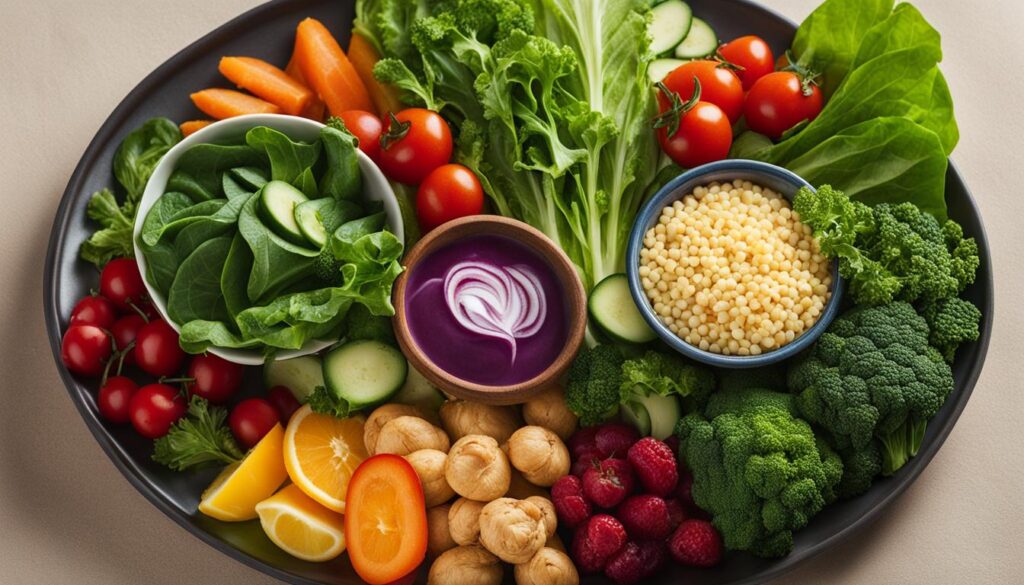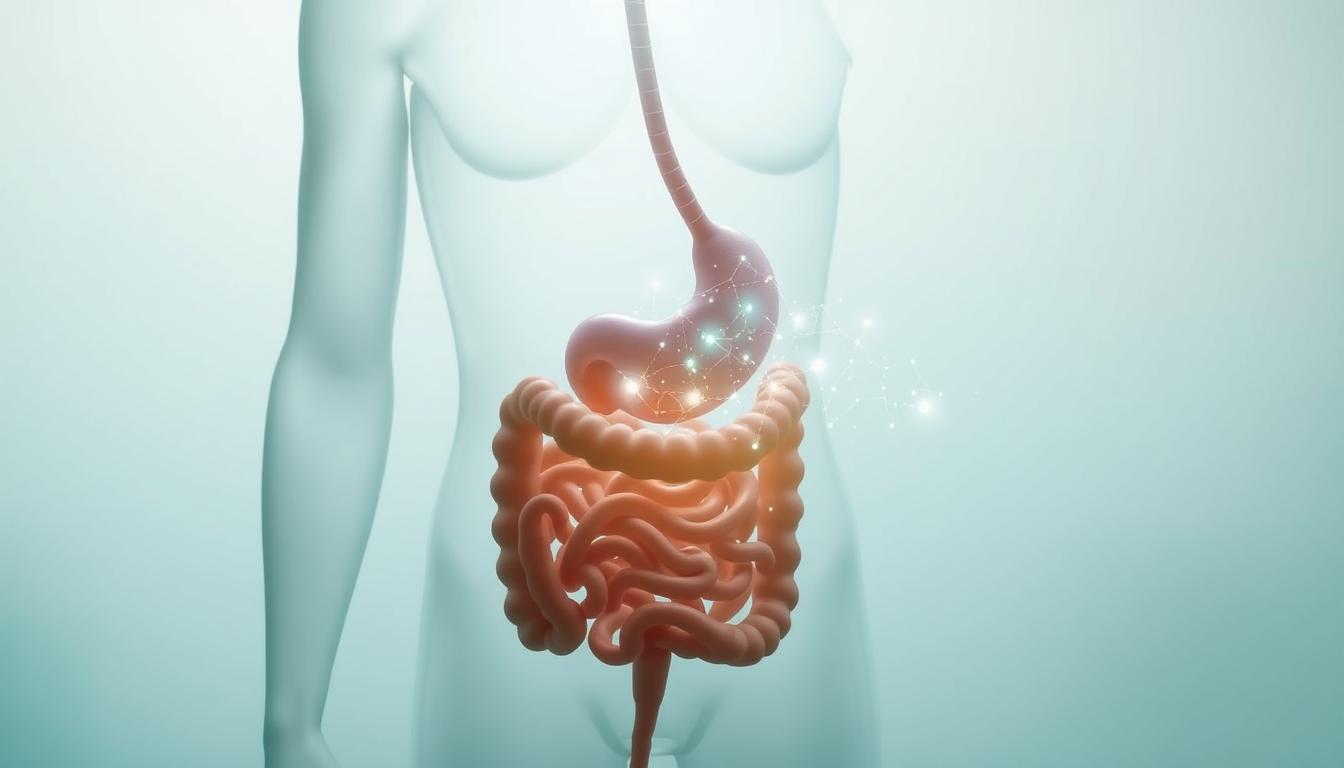Welcome to our guide on unlocking your health with an effective diet for diabetes. Managing diabetes through diet is a crucial aspect of diabetes management. By making informed choices about what we eat, we can take control of our health and improve our overall well-being. In this article, we will discuss the principles of an effective diet for diabetes and how it can potentially reverse type 2 diabetes naturally.
Key Takeaways:
- An effective diet for diabetes can play a crucial role in managing and potentially reversing type 2 diabetes.
- Jason Fung’s book, “The Diabetes Code: Prevent and Reverse Type 2 Diabetes Naturally,” offers a strict treatment plan that emphasizes nutrition as a key focus in diabetes management.
- Avoiding sugar-sweetened beverages, refined carbohydrates, and processed foods is important for diabetes management.
- Intermittent fasting can be an additional principle for reversing type 2 diabetes.
- Consulting with healthcare providers and dietitians is recommended for personalized guidance in diabetes management.
The Link Between Insulin Resistance and Diet
When it comes to managing diabetes and maintaining blood sugar control, diet plays a crucial role. One important aspect to consider is insulin resistance. Insulin resistance occurs when the body’s cells do not respond effectively to insulin, leading to elevated blood sugar levels. However, making specific dietary choices can help manage insulin resistance and promote overall health.
For individuals with diabetes, it is important to focus on healthy eating patterns and follow a low glycemic diet. The glycemic index is a measure of how quickly foods raise blood sugar levels. Foods with a low glycemic index are digested more slowly, causing a gradual increase in blood sugar levels. On the other hand, foods with a high glycemic index can cause blood sugar levels to spike quickly.
Choosing the Right Foods
When it comes to managing insulin resistance, it is crucial to choose foods that promote stable blood sugar levels. Opt for non-starchy vegetables, whole grains, and foods high in fiber. These include leafy greens, broccoli, cauliflower, whole wheat bread, oats, quinoa, and beans. These foods provide essential nutrients and fiber while minimizing the risk of blood sugar spikes.
Personalized Nutrition Plans
Every individual is unique, and what works for one person may not work for another. It is important to work with a healthcare provider or registered dietitian to create a personalized nutrition plan that considers your specific needs and preferences. They can help you navigate portion sizes, food choices, and meal timing to manage insulin resistance effectively.
| High Glycemic Index Foods to Avoid | Low Glycemic Index Foods to Include |
|---|---|
| White bread | Whole wheat bread |
| Potatoes | Sweet potatoes |
| Sugary cereals | Steel-cut oats |
| Soda | Water or unsweetened tea |
| Cookies and cakes | Fresh fruits |
Incorporating a low glycemic diet into your diabetes management plan can have significant benefits for blood sugar control and overall health. Remember to prioritize whole, unprocessed foods, and work with a healthcare professional to develop a personalized diet plan that works best for you.
What to Eat on an Insulin Resistance Diet
When it comes to managing insulin resistance through diet, making the right food choices is key. By following a diabetic meal plan, you can effectively control your blood sugar levels and improve your overall health. Here are some recommendations for foods to include in your insulin resistance diet:
1. Non-Starchy Vegetables
- Leafy greens (spinach, kale, lettuce)
- Cruciferous vegetables (broccoli, cauliflower, Brussels sprouts)
- Tomatoes
- Asparagus
These vegetables are low in carbohydrates and high in fiber, making them ideal for managing insulin resistance. They provide essential vitamins and minerals while keeping blood sugar spikes at bay.
2. Berries
- Strawberries
- Blueberries
- Raspberries
Berries are a delicious and nutritious addition to an insulin resistance diet. They are packed with antioxidants, fiber, and vitamins, and have a low glycemic index, meaning they have a minimal impact on blood sugar levels.
3. Lean Protein Sources
- Skinless poultry (chicken, turkey)
- Fish (salmon, tuna)
- Beans and legumes
- Tofu
Including lean protein sources in your meals can help stabilize blood sugar levels and promote satiety. These foods are also rich in nutrients, such as omega-3 fatty acids, which are beneficial for overall health.
4. Nuts
- Almonds
- Walnuts
- Pistachios
Nuts are a great source of healthy fats, fiber, and protein. They can help improve insulin sensitivity and support heart health. Just remember to enjoy them in moderation due to their high calorie content.
5. Whole Grains
- Quinoa
- Brown rice
- Whole wheat bread
- Oats
Choosing whole grains over refined grains is essential for managing insulin resistance. Whole grains are rich in fiber and have a lower glycemic index, making them a healthier option that won’t cause blood sugar spikes.
6. Healthy Fats
- Avocado
- Olive oil
- Nut butters
Incorporating healthy fats into your insulin resistance diet can help improve insulin sensitivity and promote heart health. These fats are rich in monounsaturated and polyunsaturated fats, which are beneficial for overall well-being.
By including these foods in your diet and following a diabetic meal plan, you can effectively manage insulin resistance and maintain stable blood sugar levels. Remember to consult with a healthcare provider or dietitian for personalized guidance and support in managing diabetes through diet.
| Foods to Include in an Insulin Resistance Diet | Foods to Avoid |
|---|---|
| Non-starchy vegetables | Sugar-sweetened beverages |
| Berries | Refined grains |
| Lean protein sources | Ultra-processed snack foods |
| Nuts | High-carb foods (noodles, dumplings, potatoes, pizza) |
| Whole grains | |
| Healthy fats |

Foods to Avoid for Insulin Resistance
| Foods to Avoid | Reasons to Avoid |
|---|---|
| Sugar-sweetened beverages | Can cause a rapid spike in blood sugar levels, contributing to insulin resistance. |
| Refined grains | Processed grains like white bread and pasta have a high glycemic index, which can worsen insulin resistance over time. |
| Ultra-processed snack foods | These foods often contain high amounts of added sugars, unhealthy fats, and refined carbohydrates, all of which can negatively impact blood sugar control. |
| High-carb foods | Foods like noodles, dumplings, potatoes, and pizza are high in carbohydrates, which can raise blood sugar levels and contribute to insulin resistance. |
When managing insulin resistance through diet, it is important to be mindful of the foods we consume. Avoiding or limiting the intake of certain foods can help to minimize blood sugar spikes and improve insulin sensitivity.
Sugar-sweetened beverages should be avoided as they can cause a rapid increase in blood sugar levels. Refined grains, such as white bread and pasta, should also be limited due to their high glycemic index, which can worsen insulin resistance over time. Additionally, ultra-processed snack foods that are high in added sugars, unhealthy fats, and refined carbohydrates should be avoided, as they can have a negative impact on blood sugar control. High-carb foods like noodles, dumplings, potatoes, and pizza should also be limited, as they can contribute to elevated blood sugar levels and insulin resistance.
By making substitutions and opting for healthier alternatives, such as using zucchini noodles instead of wheat noodles or swapping out refined grains for whole grains, we can help minimize the impact on blood sugar. Making informed choices about the foods we consume is crucial in managing insulin resistance and maintaining healthy blood sugar levels.

Quote:
“Avoiding sugar-sweetened beverages, refined grains, ultra-processed snack foods, and high-carb foods can help minimize blood sugar spikes and improve insulin sensitivity.”
Making Wise Choices in Dietary Fats
When it comes to managing diabetes through diet, making wise choices in dietary fats is crucial. Cutting down on trans and saturated fats is important for overall health, especially for individuals with diabetes who are at a higher risk for heart disease. Trans fats, found in hydrogenated oils, can be replaced with healthier options like canola oil, sunflower oil, avocado oil, or olive oil. Saturated fats, often found in animal products and full-fat dairy, should also be limited. Choosing lean protein sources, such as skinless poultry, tofu, legumes, and nuts, can provide healthy fats and protein without compromising blood sugar control.
It’s important to note that not all fats are created equal. While some fats can be harmful to our health, others are essential for our well-being. Unsaturated fats, such as those found in fatty fish, nuts, seeds, and oils derived from plants, are known to have positive effects on heart health and blood sugar control. Including these healthy fats in our diet can help us maintain a balanced and nutritious eating plan.
“Choosing the right types of fats in our diet is crucial for managing diabetes. By opting for healthier fats and reducing our intake of trans and saturated fats, we can support our overall well-being and blood sugar control.” – Dr. Sarah Thompson, Registered Dietitian
Benefits of Healthy Fats in Diabetes Management
Including healthy fats in our diet can provide numerous benefits for individuals with diabetes:
- Improved heart health: Unsaturated fats help reduce “bad” cholesterol levels and support heart health, lowering the risk of cardiovascular complications.
- Enhanced blood sugar control: Healthy fats are digested more slowly, resulting in a slower rise in blood sugar levels after meals. This can help improve blood sugar control and prevent spikes.
- Satiety and weight management: Healthy fats contribute to feelings of fullness and can help us maintain a healthy weight, reducing the risk of obesity-related complications.
By incorporating healthy fats into our meals and snacks, we can optimize our diabetic nutrition and promote better overall health. However, it’s important to consume fats in moderation, as they are calorie-dense. Consulting with a healthcare provider or registered dietitian can provide personalized guidance on the appropriate amount of fats to include in our diet.
| Fat Source | Healthy Fats | Unhealthy Fats |
|---|---|---|
| 1. Oils | Olive oil, canola oil, avocado oil, sunflower oil | Hydrogenated oils, palm oil, coconut oil |
| 2. Fish | Fatty fish like salmon, trout, and mackerel | Fried fish, fish sticks, breaded fish |
| 3. Nuts and Seeds | Almonds, walnuts, chia seeds, flaxseeds | Salted nuts, sugared nuts, fried seeds |
| 4. Dairy | Low-fat milk, yogurt, and cheese | Full-fat dairy products like whole milk and cream |
The Role of Dietary Fiber in Managing Diabetes
Dietary fiber plays a crucial role in managing diabetes by helping to control blood sugar levels. It is a type of carbohydrate that cannot be digested by the body, so it does not raise blood sugar levels. Instead, it slows down the absorption of sugars, promoting a gradual and steady increase in blood sugar. This can help prevent spikes and crashes in blood sugar levels, providing more stable energy throughout the day.
High-fiber foods also promote satiety and can help with weight management, as they tend to be lower in calories and make you feel fuller for longer. This can be particularly beneficial for individuals with diabetes who are looking to achieve or maintain a healthy weight. In addition, a diet rich in fiber has been shown to improve cholesterol levels and reduce the risk of cardiovascular disease, which is a common complication of diabetes.
To incorporate more fiber into your diet, focus on consuming fruits, vegetables, whole grains, and legumes. These foods are naturally high in fiber and offer a wide range of nutrients and health benefits. Aim to include a variety of fiber-rich foods in your meals and snacks to ensure you are getting a good mix of soluble and insoluble fiber.
| Meal | Menu |
|---|---|
| Breakfast | Oatmeal with fresh berries and a sprinkle of chia seeds |
| Lunch | Vegetable stir-fry with brown rice |
| Snack | Carrot sticks with hummus |
| Dinner | Grilled chicken breast with steamed broccoli and quinoa |
| Snack | Apple slices with almond butter |
By incorporating high-fiber foods into your diet, you can take control of your blood sugar levels and improve your overall health. Remember to stay hydrated and gradually increase your fiber intake to avoid any digestive discomfort. Consult with a healthcare provider or registered dietitian for personalized guidance and meal planning.
Gluten-Free Options for Diabetes Management
For individuals with diabetes who also have celiac disease or gluten sensitivity, following a gluten-free diet can be important. A gluten-free diet excludes the protein gluten, which is found in wheat, barley, and rye. By eliminating gluten-containing foods, individuals can manage their diabetes while also avoiding symptoms and complications associated with celiac disease or gluten sensitivity.
When following a gluten-free diet for diabetes management, it’s important to choose foods that are both gluten-free and diabetes-friendly. Here are some gluten-free options that are suitable for individuals with diabetes:
- Fresh fruits and vegetables
- Beans and legumes
- Yogurt and cheese
- Corn
- Sweet potatoes
- Quinoa and rice
These gluten-free options provide essential nutrients, fiber, and are generally low in carbohydrates. However, it’s important to note that not all gluten-free products are suitable for individuals with diabetes. Some gluten-free alternatives, such as gluten-free breads or pastas, can still raise blood sugar levels due to their high carbohydrate content. It’s important to read labels and choose gluten-free products that are also low in added sugars and carbohydrates.
| Food | Carbohydrates (per serving) |
|---|---|
| Fresh fruits and vegetables | Varies depending on the type of fruit or vegetable |
| Beans and legumes | 15-30 grams |
| Yogurt and cheese | Varies depending on the type of yogurt or cheese |
| Corn | 30 grams |
| Sweet potatoes | 20-30 grams |
| Quinoa and rice | 30 grams |
Consulting with a healthcare provider or a registered dietitian who specializes in diabetes management is recommended for individuals with diabetes who are also following a gluten-free diet. They can provide personalized guidance and help create a suitable meal plan that meets both gluten-free and diabetes management needs.
Incorporating Vegetarian Choices and Meatless Mondays
Attracting and maintaining a diabetes-friendly diet can be achieved by incorporating vegetarian choices into your meal plan. Going vegetarian for one day a week, such as participating in Meatless Mondays, can have significant health benefits for individuals with diabetes.
A vegetarian diet for diabetes can provide ample protein and fiber while reducing the intake of saturated fats and cholesterol. By opting for plant-based meals, you can enjoy a variety of whole grains, beans, lentils, vegetables, and healthy fats like olive oil and nuts. These nutritious choices not only support blood sugar control but also promote overall well-being.
By making vegetarian choices on a regular basis, you can enhance the nutritional value of your meals and diversify your diet. Experimenting with different vegetarian recipes and incorporating a wide range of fruits, vegetables, and whole grains can add creativity and flavor to your diabetes-friendly diet.
Remember, it’s essential to consult with healthcare providers and dietitians to ensure that your vegetarian choices align with your individual needs and preferences. They can provide personalized guidance and help you create a well-balanced meal plan that suits your diabetes management goals.
Conclusion
Effective diet management plays a crucial role in managing and potentially reversing type 2 diabetes. By making informed choices about what we eat, we can take control of our health and improve our overall well-being.
To effectively manage diabetes through diet, it is important to focus on blood sugar control, healthy eating, and targeted nutrient choices. This includes avoiding high-carb foods, reducing saturated fats, increasing fiber intake, and exploring gluten-free or vegetarian options.
Implementing a diabetes-friendly diet can optimize our health outcomes and support our well-being. However, it is essential to consult with healthcare providers and dietitians for personalized guidance in diabetes management. They can provide us with specific recommendations and create a personalized nutrition plan tailored to our individual needs.
By taking proactive steps to manage our diet, we have the power to make a positive impact on our diabetes. Let’s prioritize our health by making informed choices and embracing a diabetes-friendly diet that can enhance our quality of life.
FAQ
Can type 2 diabetes be reversed with diet?
Yes, type 2 diabetes can be treated and even reversed with very-low-carbohydrate diets that include intermittent fasting.
What book can provide instructions on managing type 2 diabetes?
Jason Fung’s book, “The Diabetes Code: Prevent and Reverse Type 2 Diabetes Naturally,” offers a strict treatment plan for managing and potentially reversing type 2 diabetes.
What foods should be avoided for insulin resistance?
Foods to limit or avoid include sugar-sweetened beverages, refined grains, ultra-processed snack foods, and high-carb foods like noodles, dumplings, potatoes, and pizza.
Which fats should be limited for individuals with diabetes?
Trans fats, found in hydrogenated oils, and saturated fats, found in animal products and full-fat dairy, should be limited for individuals with diabetes.
What foods are high in dietary fiber?
Foods rich in fiber include fruits, vegetables, whole grains, and legumes.
What are some gluten-free options for managing diabetes?
Gluten-free options include fresh fruits and vegetables, beans, yogurt, cheese, corn, sweet potatoes, quinoa, and rice.
How can vegetarian choices benefit individuals with diabetes?
Plant-based meals can provide ample protein and fiber while reducing the intake of saturated fats and cholesterol.
What is the key to effective diabetes management through diet?
Personalized nutrition plans that focus on blood sugar control, healthy eating, and targeted nutrient choices are key to effective diabetes management through diet.




